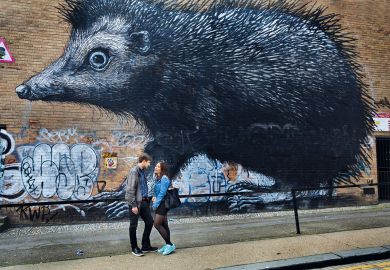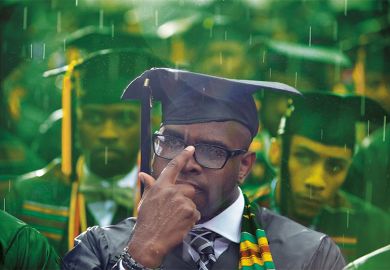I recently borrowed a book from a local library for my four-year-old son; it was called STEM Detectives: The Case of the Locked Library. Funny, I thought, this sounds suspiciously like a higher education publication. Imagine my surprise when I discovered that the book, published in 2020 and aimed at kids at Key Stage 1, really was in the business of promoting the familiar STEM agenda, showing how a group of child detectives use their knowledge of science, technology, engineering and mathematics to solve a crime.
STEM subjects are unquestionably important, and given the inequalities of access to them, sparking children’s interest is critical. But it made me wonder: where are the arts and humanities mini-investigators? Or the super-small sleuths of social science? What messages are being sent to children about those subject areas?
Typically, the message is that they offer no direct routes into jobs and that those who study them do it mostly for love. Those of us teaching in arts, humanities and social sciences know, of course, that in addition to subject-specific knowledge, students learn a lot about the world from reading literature, history, anthropology and the like. The study of culture and society inevitably provokes the most difficult political, critical and philosophical questions.
It seems clear, however, that “non-STEMers” are losing ground, both with the public, many of whom seem to consider the cost of higher education to be merited only in the case of subjects promising financial reward, and with many ministers, who see the future revolving around big science and tech. In 2020, for example, the education secretary, Gavin Williamson at the time, helped to launch a £149 million initiative to promote and support science study at all levels, while current prime minister Rishi Sunak earlier this year suggested that all pupils in England should learn maths up to the age of 18.
A typical riposte is to point out that that the UK culture industry grinds out £13 million per hour. And the British Academy’s relatively new SHAPE initiative promoting arts, humanities and social science “for people and the economy/environment” is a laudable attempt to push back against the idea that only STEM can address society’s challenges. But I want to suggest a way in which expertise from SHAPE subject areas might be deployed more strategically, engaging more directly with the world and, crucially, giving students the skills they need for the workplace.
At the University of Sussex, an institution known since the 1960s for its alternative thinking, we’ve launched a new kind of liberal arts BA that is doing exactly those things. Unlike the American liberal arts model adopted by a number of UK universities, which offers students access to a wide spread of subjects, our course, introduced in 2021-22, uses an interdisciplinary, even post-disciplinary, approach to study the fundamental challenges faced by society.
Core “global humanities” modules directly address big and complex issues uncontainable in a single discipline, bringing together colleagues from across the arts and social sciences to offer multiple perspectives on climate change, globalisation, automation, “culture wars”, inequality, populism and migration. A parallel set of core modules teaches students complementary practice-based skills, via projects including video-making, critical art practice, acoustic ecology, psychogeography, interventions in museums, citizens’ assemblies, thinktank policy-making and strategic communications campaigns – almost always in partnership with our multi-sector advisory board. The final year is a supported but independent project in the community.
The traditional American liberal arts model is coming under fire in the US itself. Responding to the perceived unworldliness of the arts, Costas Spirou, vice-president of Georgia College and State University wrote in these pages in 2022 that “higher education must go beyond the strategy of defending the power and value of a liberal arts education”, calling on colleges to connect disciplines more productively and to recognise the need for career preparation.
But it isn’t just the US that needs to get serious about fitting humanities and social science students for life after. In some cases, of course, the traditionally siloed ivory-tower approach delivers impressive worldly returns. Boris Johnson, for example, landed quite a big job armed with his University of Oxford Classics degree. But, actually, isn’t this the problem? The cultural capital of a humanities degree from a historic or prestigious university is still sufficiently fungible, even in today’s volatile job market, not to require it to change. And given the aspiration of the rest of the sector towards the “gold standard” set by such institutions, the kind of pedagogic revolution we have undertaken is slow to catch on.
But catch on it must. Our interdisciplinary, challenge-focused pedagogy stretches our students intellectually and experientially, allowing them to realise so much more of their potential than if they were locked into one or two specialisms. In the process, they rack up impressive lines for their CVs and enter the workplace with a wealth of ideas, skills and relevant knowledge.
We don’t have to throw the baby out with the bathwater. Disciplinary research will always underpin post-disciplinary teaching, and we can teach students to be critical as well as market-ready. But the biggest challenges that humankind faces will be solved by people and teams who can not only analyse and calculate, but also conceptualise, persuade and create. If we can prepare those people and teams, we will have a compelling argument that studying the arts, humanities and social sciences has never been more important.
Doug Haynes is a reader in American literature and visual culture at the University of Sussex.
Register to continue
Why register?
- Registration is free and only takes a moment
- Once registered, you can read 3 articles a month
- Sign up for our newsletter
Subscribe
Or subscribe for unlimited access to:
- Unlimited access to news, views, insights & reviews
- Digital editions
- Digital access to THE’s university and college rankings analysis
Already registered or a current subscriber?










